
The greatest trick a monster movie can pull is convincing everyone it’s not actually a monster movie, and that’s a trick that Steven Spielberg has managed to pull off twice in his career. I’m not saying that Spielberg’s contention that they treated the dinosaurs in Jurassic Park like real animals and not generic movie monsters is untrue, I just think that it is almost impossible to portray dinosaurs in film without being pulled by the gravity of the monster movie. As I have argued before, the history of dinosaurs in movies and the history of monster movies are irrevocably intertwined, the latter still spiritually aligned with the timeless desire to see these seemingly impossible creatures alive in some fashion, a dream that only the medium of film was able to materialize—from Willis O’Brien and Ray Harryhausen onward, every advance in the portrayal of fictional creatures was applied to dinosaurs, and vice-versa. I also think anyone who loves dinosaurs—and Jurassic Park alone created another new generation of miniature paleontology freaks—loves them because they are both real animals and also monstrous, wonderful to imagine and terrifying to behold. By acknowledging that complicated appreciation of the subject, Jurassic Park introduced something bold and resonant to movies beyond just the ballyhooed technological breakthroughs and changes to the very concept of Hollywood blockbusters that it ushered in.
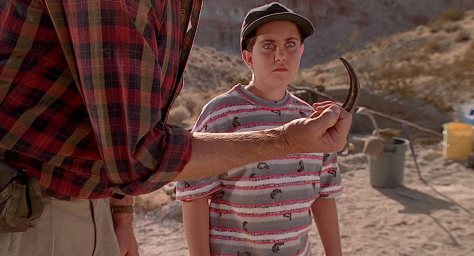
Those technological breakthroughs are very hard to ignore, though—JP‘s use of both animatronics and CGI, just enough of both to keep one from detracting from the reality of the other, was a culmination of special effects in and it out of creature features over the previous decade, all of the lessons learned and hard work applied to something of massive scope. It in turn would change the way special effects would be approached in movies, with CGI eventually becoming the all-encompassing mode, oftentimes without the careful thought and planning that has allowed this movie’s effects to stand the test of time. Following this movie, there would be a revival of both disaster movies (which Jurassic Park resembles in structure) and big budget monster movies, all of them copying from its playbook, but very few of them capturing the same magic. Even its own sequels immediately suffered from diminishing returns, but that seems pretty much par for the course when it comes to classic monster movies.
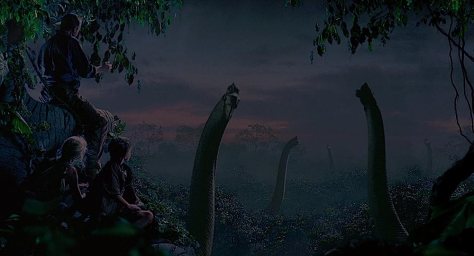
There’s a reason why there’s that sense of magic in this movie that is lacking in the movies that followed in its wake. You really get the sense that this was the thing that movie effects pioneers like Stan Winston, Dennis Muren, Phil Tippett (three people who have been recurring presences in my monster movie write-ups), and their crews were building towards, a movie where their fabricated beasts would be indistinguishable from reality. They got to be the ones who finally bring the dinosaurs back to life, fulfilling the dreams of almost every childhood creature fan, and you can feel it on screen.
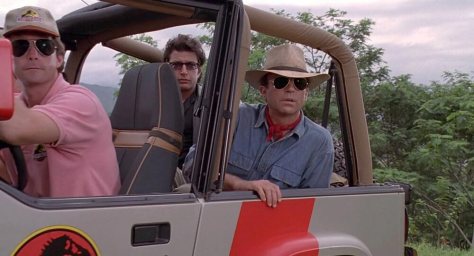
Which, of course, also plays into the themes of the movie itself. The choice by Spielberg and co-writer David Koepp, working alongside original novel writer Michael Crichton, to leaven the traditional theme of big business and its engineer lackeys making poor decisions with a sense of genuine showmanship and a childlike desire to bring wondrous things to the world makes a standard mad scientist/techno-thriller plot into something less cynical. Crichton essentially recycled the concept of Westworld for his original book, replacing the Luddite bugbear of artificial intelligence with the Luddite bugbear of genetic engineering, with a similar sense of the entertainment industry seeking out ever more dangerous thrills to bring to paying customers. But where Westworld had the dryness of an early seventies vacation for adults, a mild fantasy orchestrated by emotionless professionals staring at computer monitor readouts, the nature of theme parks had changed over the next two decades, becoming flashier, dedicated, and more kid-friendly—seeing dinosaurs is probably more of a child’s fantasy than anything, and while the professionals staring at computer monitor readouts are still part of the picture, the presentation is bigger, more devoted to bringing out that childlike sense of wonder.

Although often presented as an ebullient figure, Richard Attenborough’s John Hammond is still mired in the business—the presentation of the park is a market-tested fabrication, a sparkling visitor centre with gift shop up and running before they even know if putting living humans and living dinosaurs in the same space is a tenable idea, and the very cinematic/theme park approach to explaining the science behind it straddles the line between sincerity and corporate propaganda. At the same time, the movie goes out of its way to show you that this thing means more than money to him. Hammond has the money and the means to do something impossible, and that aforementioned childlike sense of wonder animates his push to make it reality, not just for himself, but for kids like his grand-kids, and for the world at large. He wants to see dinosaurs live again, and he knows that’s what many other people want as well—and, of course, that’s also what drives Spielberg and his crew to make this movie. Spielberg radically altered Hammond’s character from Crichton’s novel because he saw a bit of himself in him as a consummate entertainer, but while he’s not as blatantly self-serving and immoral in the film (and survives to the end), he still shows a barely-concealed sense of frustration at other people hindering his ability to do what he wants, or when things inevitably veer out of his control. Maybe Spielberg is really being honest about what it’s like to be a consummate entertainer playing with untold millions of dollars.

A recurring theme in all monster movies is a loss of control over our world, monsters representing the chaotic things completely outside ourselves. We like to think our grasp of reality is absolute, but we are regularly reminded that it never can be. From the beginning, Jeff Goldblum’s chaotician Ian Malcolm is there to remind every other character about this, how the park, from its conception, was inevitably going to fall apart—since they had a cartoon explain the movie’s flimsy science, the scientist is here to explain the themes. Goldblum and/or the script are able to do this without coming as off condescending to the audience or the genre, instead showing a genuine genre awareness (he gets to be the one to reference King Kong when they approach the big doors) that balances out the conflicted naivety found in the other characters.
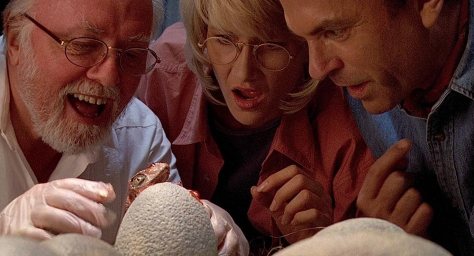
The film frontloads the sense of awe and beauty of these living fossils walking around in plain sight, with our leads interacting with only the “friendly” dinosaurs to begin with—it represents the image Hammond wants for his park. Of course, this overlooks the fact that, herbivorous or not, a brachiosaurus and a triceratops would likely be just as dangerous as any predatory animal, but that’s also part of the fun: no amount of cuddly marketing and photo op moments with docile creatures can hide the fact that part of the appeal of dinosaurs is the fact that they are dangerous and terrifying. Sam Neill’s Alan Grant and Laura Dern’s Ellie Satler embody the conflicting emotions this concept creates for people who genuinely fascinated by dinosaurs—despite being a scientist, Grant is also clearly a prehistoric fanboy who loves to pull out facts about velociraptors to impress and scare people (his initial annoyance with Tim at least partially comes from recognizing a younger and more uncontrollably enthusiastic version of himself), and with every new sight he sees that confirms or denies all his theorizing (which is pretty much the only thing paleontology can do), its clear that he is struck with equal parts joy and trepidation. He is living out the fantasy of his profession, but being in his profession, he knows just how wrong this thing can go.
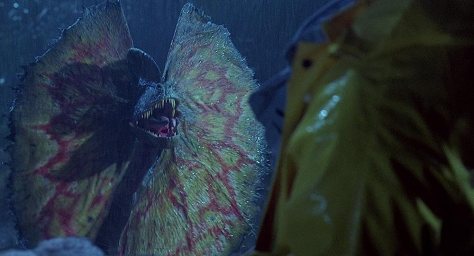
The conflict between that sincere pursuit of the astonishing and the ugly chaos of its reality is reflected in its violent thrills—for all his reputation for sentimentality, the gruesomeness of many of Spielberg’s movies reveal the taste for carnage of someone raised on morally indifferent pulp adventure stories. Following the beats of a disaster movie once things go sideways, the movie becomes a series of survival scenarios for our cast to work around, and untimely death is handed out to the supporting cast regardless of their actions. Characters we see just trying to do their jobs, like Samuel L. Jackson’s character or Bob Peck’s Muldoon, and people whose greatest crime is being a little bit annoying like Martin Ferrero’s lawyer, get it just as bad as Wayne Knight, the corporate saboteur who intentionally made the bad situation even worse. Even if the movie is still a controlled thrill ride, it knows how to create the illusion that prevents its scenario from feeling in any way safe.

When the movie finally unleashes the T. Rex and the velociraptors (the latter surprisingly late—only in the last half hour), we in the audience do in fact want to see them enact some violence, because that is what we know them to do (and that’s what made kids of the time like me want to own their action figures.) As much as this movie wants to have us to believe that these things are real animals, the stormy T. Rex attack scene or the raptor stalk-and-slash moments are pure monster movie at their highest level of execution—a giant monster and smaller, Alien-style creatures in the same movie, portrayed in scenes that almost every creature feature following Jurassic Park copied wholesale. While we at least get to see the T. Rex engage in more naturalistic behaviour when it chases down the herd of Gallimimus (a scene that bears a great resemblance to one in Harryhausen’s Valley of Gwangi), the other menacing dinosaurs only appear to threaten the human cast. Especially considering that they resemble their namesake in only nominal ways, the movie’s velociraptors (and the dilophosaurus that appears in one scene) are portrayed as true movie monsters, intelligent creatures of pure malice. We are meant to cheer when the two remaining raptors are mangled by the T. Rex at the end of the movie to the movie’s iconic theme song, I guess because the raptors have a body count of at least three compared to the T. Rex’s one.

But in the end, that mayhem is what we want. As accurate or inaccurate these depictions may be to our understanding of dinosaurs at the time (and the movie at least had paleontologist Jack Horner on staff to supervise the designs), that animalistic brutality does feel correct in spirit, and reflects the inherent chaos that they represent to us, and that makes them so compelling. Having spent most of our lives only reading about them, some of us might want desperately just to see these animals as living, breathing things, not just as hypothetical recreations based on petrified remains, but we may also recognize that our species were never meant to occupy the same space. As creatures from another time, or as the ill-advised creations of humans (this movie mixes multiple monster milieus), they are utterly beyond us, which every character except Hammond recognizes immediately, as much as they marvel at their mere existence. These are reiterations of age old themes in the world of monster stories, but what stands out is the modern sensibility that leads it to alternatively embrace and grapple with the spectacle of it all, and to acknowledge the problems at the heart of seeing dangerous animals (living, dead, or fictional) as entertainment or objects of child-like fascination.
